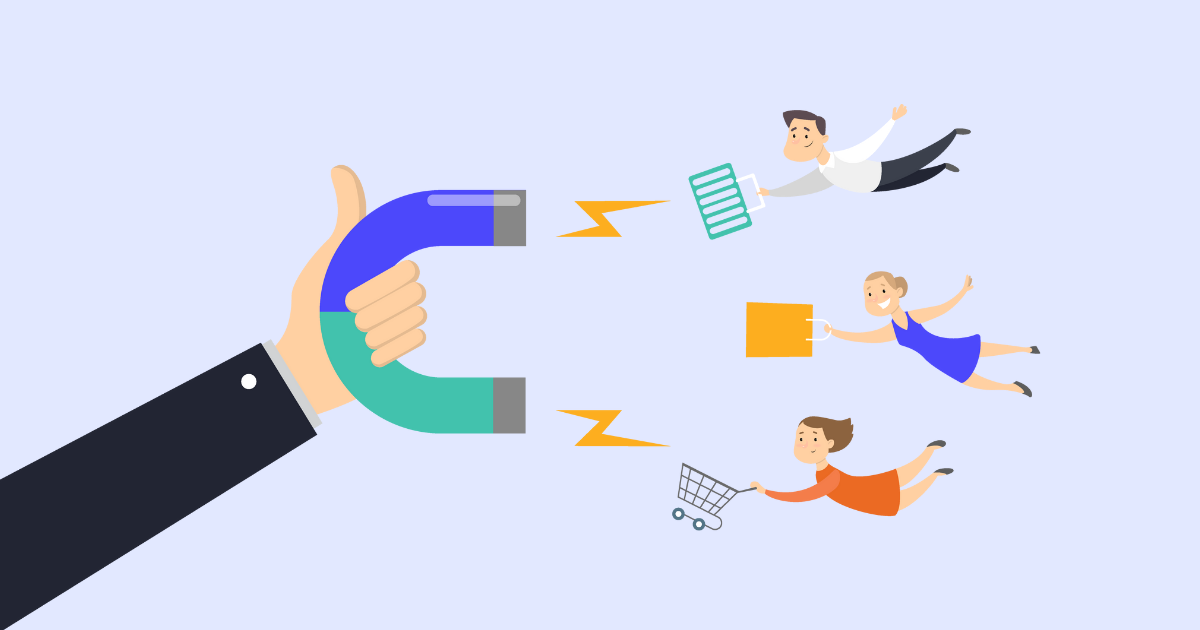We’ve all heard it: retaining existing customers is far less expensive than acquiring new ones. But with customers spoiled for choice in the age of online shopping, even offering outstanding products at reasonable prices may not be enough to turn one-time shoppers into long-term fans.
A customer retention strategy gives shape and structure to the ways you will attract, engage, and maintain relationships with your customers. This maximizes the chances of them shopping with you again in the future – and recommending you to their family and friends.
In this article, we’ll explain what customer retention really means and why it should be high up on your list of priorities. Then, we’ll share guidelines and best practices on setting up your own customer retention strategy.
What is customer retention?
Customer retention refers to the ability of a business to keep its existing customers over time. It involves building strong relationships, offering excellent service, and providing tangible value.
Often, businesses use the term “customer retention” to focus on strategies to encourage repeat purchases – i.e. to prevent customers from switching to competitors.
However, retention is part and parcel of customer loyalty, a broader concept that encompasses an emotional attachment and commitment to a brand or company.
While retention ensures continued purchases, loyalty fosters advocacy and willingness to recommend the brand to others.
Why customer retention matters
For ecommerce businesses of all sizes and growth stages, customer retention and loyalty are pillars of profitability and growth.
Acquiring brand-new customers almost always comes with costs attached, and in some industries, that investment can be significant. Increasing customer retention by just 5% can boost profits by 25% to 95% over a given period of time.
It’s not just about short-term gains, either: loyal customers are associated with increased lifetime value and brand advocacy. They’re more likely to make repeat purchases, provide valuable feedback, and contribute to positive word-of-mouth marketing, all of which are vital for business success.
Customer retention metrics and formulas
Before you can start developing your own customer retention strategy, you’ll need to understand as much as possible about your customers’ current shopping habits, and identify which customers have the greatest potential to stick with your brand.
The better your customer data, the more easily you’ll be able to figure out how to focus your efforts. These three metrics are especially useful to track, and will help you set realistic goals for your retention strategy.
We’ll explain how to calculate these metrics yourself, but keep in mind that specialized customer retention software can take care of the grunt work for you (more on software later).
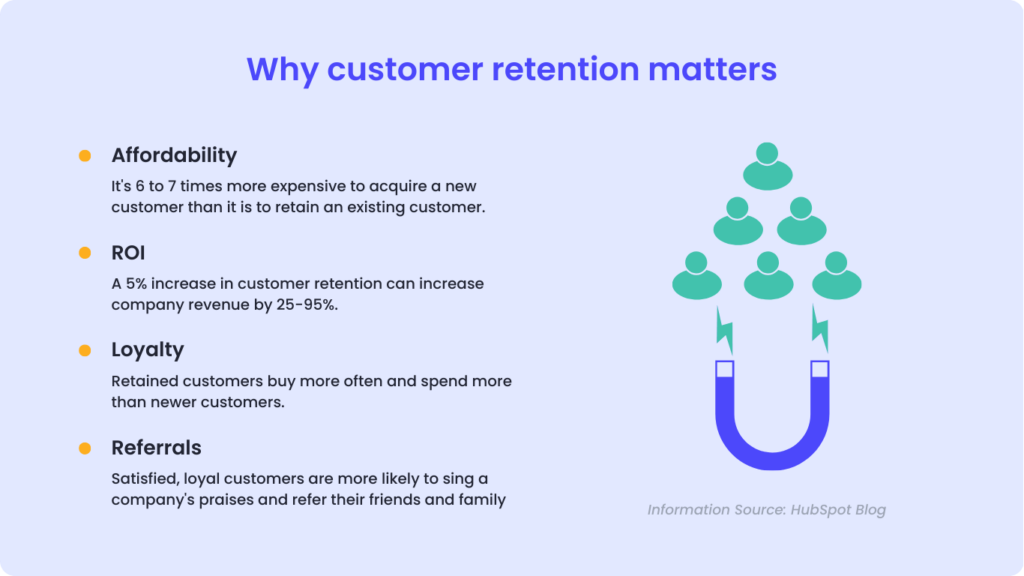
Information and Data Source: HubSpot
Customer Retention Rate
Customer Retention Rate measures the percentage of customers your business has retained over a specific period. To calculate it, divide the number of customers at the end of the period by the number at the start, subtract any new customers acquired during that time, and then divide by the initial number of customers.
For instance, if you started with 100 customers, gained 20 new ones, and ended with 90, the calculation would be (90-20)/100 = 70%.
A higher retention rate signifies better customer satisfaction and loyalty, indicating a healthier business with more consistent revenue streams.
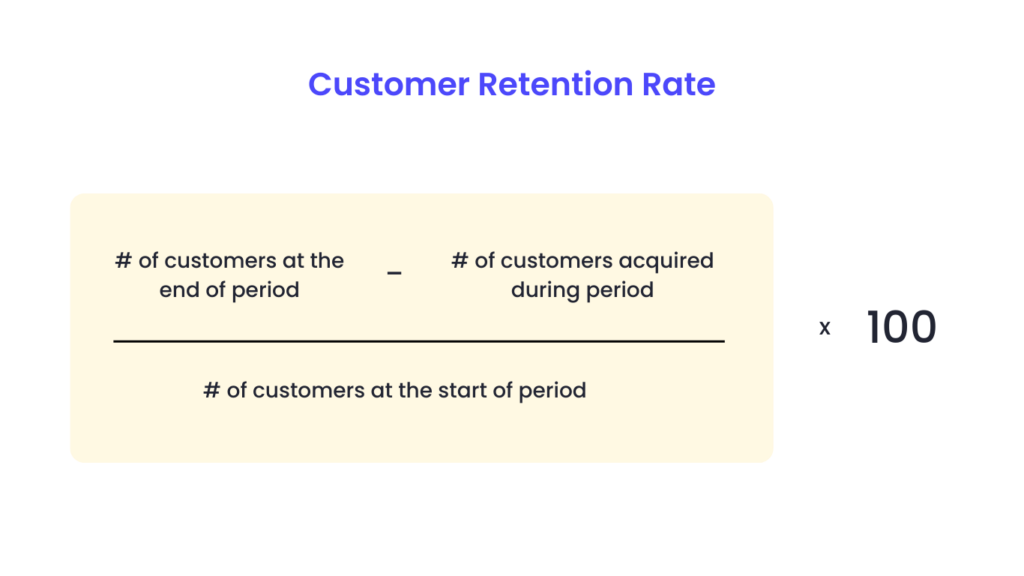
Customer Lifetime Value (CLV)
Customer Lifetime Value (CLV) is a metric that quantifies the total value a customer brings to a business over their entire relationship with that business. In other words, it takes into account not only the revenue generated from initial purchases but also the potential for future purchases and ongoing engagement.
CLV takes a bit of effort to calculate manually, but its capacity to predict future behavior makes it worth the effort.
It provides insights into the long-term profitability of your customer base and can help you make informed decisions regarding marketing strategies, customer acquisition costs, and resource allocation.
You can calculate CLV for a single customer, a segment of customers, or all customers. Either way, you’ll need three values to get started.
- Average Purchase Value – This refers to the average amount of money a customer spends on each transaction with your business. To calculate it, sum up the total revenue generated from all purchases over a specific period (e.g. a month or a year) and divide it by the total number of purchases made during that same period. For example, if your business made $10,000 in revenue from 500 transactions in a month, the average purchase value would be $10,000 / 500 = $20 per transaction.
- Purchase Frequency – Purchase frequency represents how often a customer makes purchases from your business within a given timeframe. To calculate this, count the total number of transactions made by all customers within your scope over a specific period (e.g., a month or a year) and divide it by the total number of unique customers during that same period. For instance, if there were 1,000 transactions made by 200 unique customers in a year, the purchase frequency would be 1,000 / 200 = 5 transactions per customer per year.
- Customer Lifespan – This is the average duration of time that a customer continues to engage with your business. To calculate this, determine the length of time between a customer’s first and last purchase (or the end of their engagement). Then, calculate the average lifespan across all customers in your scope. For example, if Customer A made their first purchase in January 2019 and their last purchase in December 2021, their lifespan would be 3 years. Repeat this calculation for all customers and then find the average lifespan across the customer base.
Once you have these three values, simply multiply them together to find your CLV.
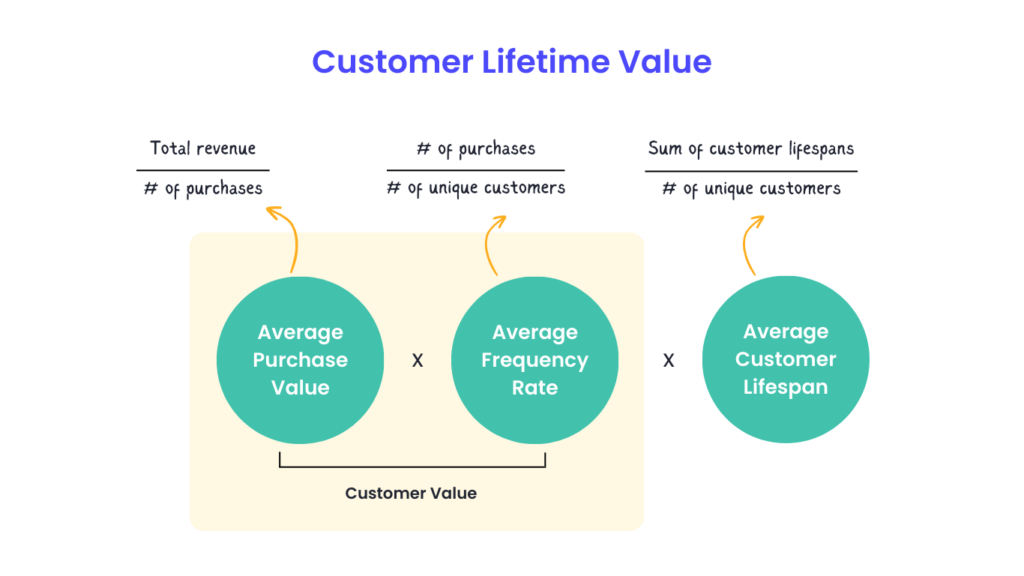
Repeat Purchase Rate
Repeat Purchase Rate measures the percentage of customers who make more than one purchase from a business over a specific period.
To calculate it, divide the number of customers who made repeat purchases by the total number of unique customers during the same period, then multiply by 100 to get the percentage. For example, if 200 customers made repeat purchases out of 500 unique customers in a month, the Repeat Purchase Rate would be (200 / 500) x 100 = 40%.
A higher rate indicates strong customer loyalty and satisfaction.

Effective Customer Retention Strategies
Once you’ve set your customer retention goals, it’s time to zero in on ways to reach them.
Research has shown the following three approaches to have a positive impact on retention and loyalty, so incorporating elements of each one into your own strategy is a worthy goal.
Personalization
Offering personalized experiences is an effective way to build an emotional bond with your customers.
In a recent survey, a whopping 78% of customers stated that receiving personalized and tailored communications, rather than generic content, would make them more likely to repurchase from a company.
Tailoring interactions based on individual preferences, purchase history, and behavior works on two levels. Firstly, customers immediately see products and services that align with their interests, increasing the likelihood of a purchase.
Secondly, it demonstrates that you’re interested in your customers’ needs, interests, and point of view. Over time, they come to associate your brand with feeling valued and understood – important underpinnings of trust.
To introduce personalization, you’ll need access to customer data.The more you have, the better, but don’t worry if your data is limited to start with. One of the great things about personalization is that the more you do it, the more information you tend to accumulate on your customers, giving you the means to refine and expand on your strategies as time goes on.
For tips on getting started, check out our article on how to use personalization in marketing.

Source: Sephora
Quality customer service
Delivering exceptional customer service is paramount for fostering loyalty and long-term retention. According to research by Statista, 83% of U.S. consumers cite customer service as an important or critical driver of brand loyalty.
Quality customer service entails being responsive, knowledgeable, and empathetic to customer needs and concerns. Promptly addressing inquiries, resolving issues efficiently, and going above and beyond to exceed expectations leave a positive impression on customers, enhancing their overall experience.
Moreover, outstanding customer service builds trust and loyalty by demonstrating a genuine commitment to customer satisfaction. When customers feel valued and supported, they’re more likely to remain loyal to your brand and recommend it to others.
To ensure quality customer service, prioritize ongoing training for your support team, empower them to make decisions autonomously, and actively seek and incorporate customer feedback into your processes.
By prioritizing customer satisfaction at every touchpoint, you can cultivate strong relationships, reduce churn, and ultimately drive higher retention rates.
Loyalty programs
Implementing effective loyalty programs can significantly boost retention rates by incentivizing repeat purchases and rewarding customer loyalty. In fact, 79% of American consumers report making purchases more frequently as a result of loyalty programs.
Loyalty programs can take various forms, such as point-based systems, tiered rewards, or exclusive perks. By offering tangible benefits, such as discounts, freebies, or early access to sales, you encourage customers to engage with your brand regularly and remain loyal over time.
Loyalty programs foster a sense of appreciation and exclusivity. As customers accumulate points or progress through tiers, they feel valued and recognized for their loyalty, enhancing overall satisfaction.
To maximize the effectiveness of your loyalty program, ensure it’s easy to understand, accessible across multiple channels, and aligned with your brand values. Regularly communicate program updates, rewards, and promotions to keep customers engaged and motivated to participate.
By implementing a well-designed loyalty program, you can cultivate long-term relationships, drive repeat business, and ultimately achieve higher retention rates.
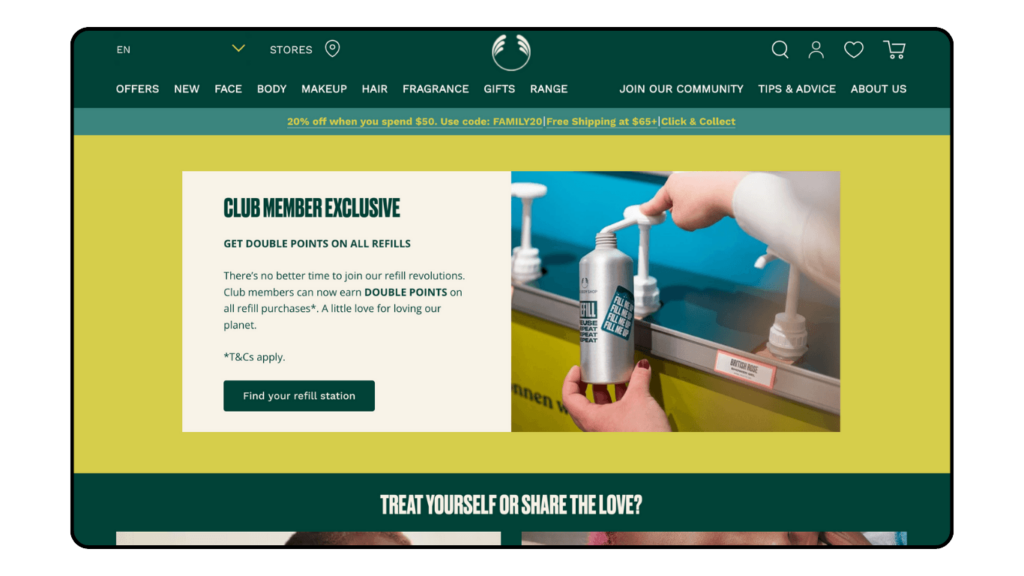
Source: The Body Shop
Repeat Purchase Rate
Repeat Purchase Rate measures the percentage of customers who make more than one purchase from a business over a specific period.
To calculate it, divide the number of customers who made repeat purchases by the total number of unique customers during the same period, then multiply by 100 to get the percentage. For example, if 200 customers made repeat purchases out of 500 unique customers in a month, the Repeat Purchase Rate would be (200 / 500) x 100 = 40%.
A higher rate indicates strong customer loyalty and satisfaction.
What is a Customer Retention Program?
Implementing a customer retention program simply means taking a strategic approach to engage and retain existing customers.
The primary objectives of these programs are to reduce customer churn, increase customer lifetime value, and foster long-term loyalty.
Effective customer retention programs combine a variety of tactics and strategies tailored to meet the specific needs and preferences of a business’s customer base.
In designing your own program, follow these steps to focus your thinking and ensure you cover all the bases.
- Understand your customers – Start by analyzing customer data to gain insights into their preferences, behaviors, and pain points. Identify segments of your customer base with the highest churn rates or lowest engagement levels.
- Set clear objectives – Define measurable goals for your retention program, such as reducing churn by a certain percentage or increasing repeat purchase frequency. These objectives will guide your strategy and help evaluate its effectiveness.
- Enhance the customer experience – Focus on delivering exceptional customer service across all touchpoints, from pre-sales inquiries to post-purchase support. Personalize interactions, resolve issues promptly, and exceed customer expectations to build trust and loyalty.
- Implement loyalty initiatives – Introduce a loyalty program tailored to your customers’ preferences and purchasing habits. Offer rewards, discounts, or exclusive perks to incentivize repeat purchases and reward loyal patrons.
- Communicate regularly – Stay connected with your customers through personalized communication channels, such as email newsletters, social media, or mobile apps. Provide relevant updates, offers, and content to keep customers engaged and informed.
- Solicit feedback – Actively seek feedback from customers to understand their satisfaction levels and areas for improvement. Use surveys, reviews, and feedback forms to gather insights and identify opportunities to enhance the customer experience.
- Iterate and optimize – Continuously monitor the performance of your retention program and iterate based on feedback and data analysis. Test different strategies, promotions, and messaging to identify what resonates most with your audience.
By implementing a customer retention program tailored to your business’s specific needs and objectives, you can effectively engage and retain your existing customer base, drive long-term loyalty, and achieve sustainable growth.
Using Customer Retention Software To Improve Loyalty
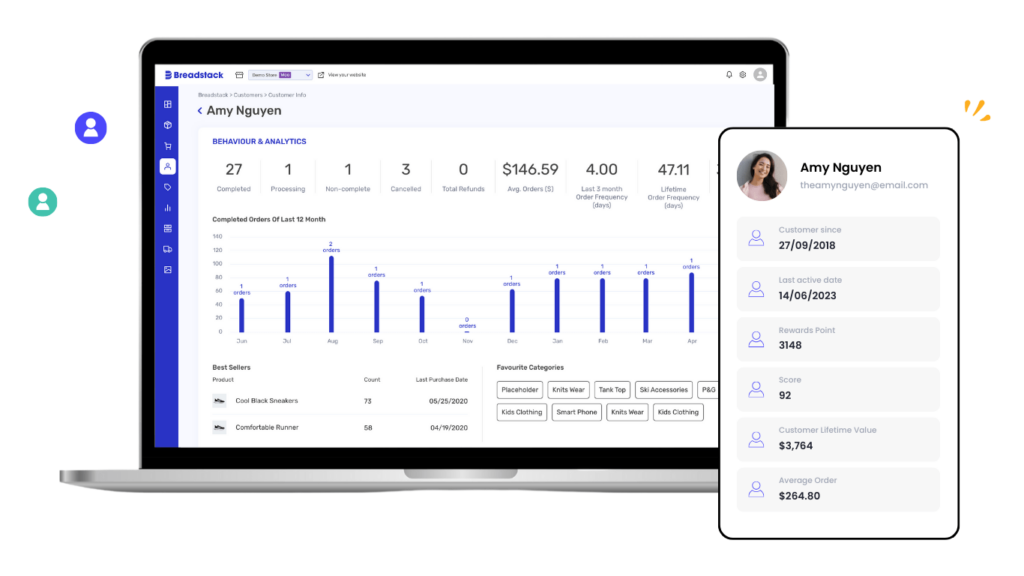
When it comes to improving customer retention, insight is half the battle. Specialized software solutions can save you from drowning in calculations by providing the information you need in a relevant, digestible, and up-to-the-minute format.
Customer retention software like Breadstack collects and analyzes customer data, such as purchase history, engagement metrics, and feedback, to identify patterns and trends.
With just a few clicks, you can segment customers based on behavior and preferences, allowing you to target your retention strategy.
And with real-time data at your fingertips, you’ll have an easier time seeing which tactics are helping or hindering you. The faster you can adjust your strategy, the sooner you’ll meet your goals.
Curious how Breadstack can help you boost customer retention? Book a free demo today!
